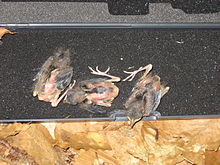Ovenbird
| Ovenbird Temporal range:
| |
|---|---|

| |
| Scientific classification | |
| Domain: | Eukaryota |
| Kingdom: | Animalia |
| Phylum: | Chordata |
| Class: | Aves |
| Order: | Passeriformes |
| Family: | Parulidae |
| Genus: | Seiurus Swainson, 1827 |
| Species: | S. aurocapilla
|
| Binomial name | |
| Seiurus aurocapilla (Linnaeus, 1766)
| |

| |
| Range of S. aurocapilla Breeding range Wintering range
| |
| Synonyms | |
| |
The ovenbird (Seiurus aurocapilla) is a small songbird of the New World warbler family (Parulidae). This migratory bird breeds in eastern North America and winters in Central America, many Caribbean islands, Florida and northern Venezuela.[2][3]
Taxonomy
The
Before the recent genetic studies were carried out, the waterthrushes were also included in Seiurus;[3][5] these are now treated separately in the genus Parkesia as they are not very closely related to the ovenbird.[4]
The species name aurocapilla is a noun phrase, so the original spelling is retained, not changed according to the gender of the genus name; Linnaeus originally named it Motacilla aurocapilla, and the ending is not changed to -us as commonly cited in the past.[6] Etymologically aurocapilla comes from Latin and means "golden haired" and Seiurus is from Ancient Greek seiō, "to shake", and oura, "tail".[7]
Description


Ovenbirds are large wood warblers and may sometimes be confused by the untrained for a thrush. Adults measure 11–16 cm (4.3–6.3 in) long and span 19–26 cm (7.5–10.2 in) across the wings.[8][9][10] They weigh 19 g (0.67 oz) on average,[11] with a range of 14–28.8 g (0.49–1.02 oz).[8] Among standard measurements, the wing chord is 6.8 to 8.3 cm (2.7 to 3.3 in), the tail is 5 to 5.8 cm (2.0 to 2.3 in), the bill is 1.1 to 1.3 cm (0.43 to 0.51 in) and the tarsus is 2 to 2.3 cm (0.79 to 0.91 in).[3] They tend to be heavier in winter and particularly at the start of their migration.[12] They have olive-brown upperparts and white underparts heavily streaked with black; the flanks have an olive hue. A white ring surrounds the eyes, and a black stripe runs below the cheek. They have a line of orange feathers with olive-green tips running along the top of their head, bordered on each side with blackish-brown. The orange feathers can be erected to form a small crest. The eyes and the upper part of the thin pointed beak are dark, while the lower beak is horn-colored and the legs and feet are pinkish.[2]
Males and females look alike. Immature birds have
The main song of the ovenbird is a series of strident, relatively low-pitched, bisyallabic motives repeated without pause about eight times and increasing in volume. Usually, the second syllable in each motive is sharply accented: "chur-tee’ chur-tee’ chur-tee’ chur-tee’ chur-TEE chur-TEE chur-TEE!" Male ovenbirds utter a sweet chattering song in the air at twilight, after the manner of the
Range and ecology
Their breeding
In winter, they dwell mainly in lowlands, but may ascend up to 1,500 m (4,900 ft)
This bird seems just capable of crossing the
Ovenbirds forage on the ground in dead leaves, sometimes hovering or catching insects in flight. This bird frequently tilts its tail up and bobs its head while walking; at rest, the tail may be flicked up and slowly lowered again, and alarmed birds flick the tail frequently from a half-raised position. These birds mainly eat terrestrial arthropods and snails, and also include fruit[17] in their diet during winter.[2]
The nest, referred to as the "oven" (which gives the bird its name), is a domed structure placed on the ground, woven from vegetation, and containing a side entrance. The female usually lays 4-5 eggs speckled with brown or gray. Only the female incubates, for 11-14 days. Young are
The placement of the nest on the ground makes
The ovenbird is vulnerable to
In literature
It is the subject of a poem by Robert Frost, "The Oven Bird", published in his poetry collection Mountain Interval in 1916. Robert Bly also makes reference to "the nimble oven bird" in his short poem "The Slim Fir Seeds".
References
- ^ . Retrieved 21 February 2024.
- ^ ISBN 0-8014-9600-4
- ^ ISBN 0-7136-3932-6.
- ^ PMID 20696258.
- ISBN 0-679-45122-6.
- ^ David, N.; Gosselin, M. (2002). "Gender agreement of avian species names" (PDF). Bull. Brit. Orn. Club. 122 (1): 14–49. [Seiurus aurocapilla, item #169, p. 38].
- ISBN 978-1-4081-2501-4.
- ^ a b Ovenbird, Life History, All About Birds – Cornell Lab of Ornithology. Allaboutbirds.org. Retrieved on 2012-08-24.
- ^ Smithsonian Tropical Research Institute-Seiurus aurocapilla. Biogeodb.stri.si.edu. Retrieved on 2012-08-24.
- ^ Ovenbird (Seiurus aurocapilla) Archived 2014-02-02 at the Wayback Machine. Planet of Birds (2011-06-08). Retrieved on 2012-08-24.
- ^ Seiurus aurocapilla (Ovenbird). Global Species. Retrieved on 2012-08-24.
- Olson, Storrs L.; James, Helen F.; Meister, Charles A. (1981). "PDF fulltext Winter field notes and specimen weights of Cayman Island Birds" (PDF). Bulletin of the British Ornithologists' Club. 101 (3): 339–346.
- New International Encyclopedia(1st ed.). New York: Dodd, Mead.
- Wilson Bulletin. 18 (2): 47–60.
- ^ Ohio Ornithological Society (April 2004). "Annotated Ohio state checklist" (PDF). Archived from the original (PDF) on 2004-07-18. Retrieved 2008-02-12.
- ^ Rogers, M. J. et al. (2005). Report on rare birds in Great Britain in 2004. British Birds 98: 628–694 [Ovenbird, p. 688].
- .
- Ovenbird Species Account – Cornell Lab of Ornithology
- Ovenbird – Seiurus aurocapillus – USGS Patuxent Bird Identification InfoCenter
- "Ovenbird media". Internet Bird Collection.
- Overbird photo gallery at VIREO (Drexel University)
- Ovenbird info
 Texts on Wikisource:
Texts on Wikisource:
- Robert Frost, "The Oven Bird," Mountain Interval, 1916
- "New International Encyclopedia. 1905. If you would like more facts about the Ovenbird click here

